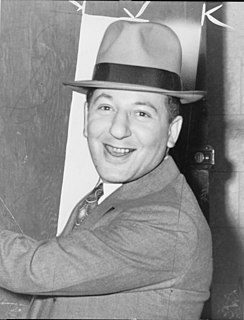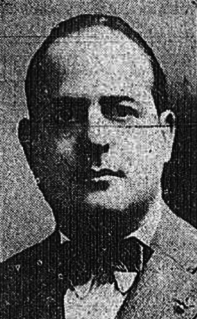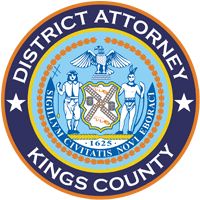Related Research Articles
Murder, Inc. was an organized crime group, active from 1929 to 1941, that acted as the enforcement arm of the Italian-American Mafia, the Jewish Mob, and other closely connected organized crime groups in New York City and elsewhere. The group was composed of Jewish-American and Italian-American gangsters, and members were mainly recruited from poor and working-class Jewish and Italian neighborhoods in Manhattan and from the Brooklyn neighborhoods of Brownsville, East New York, and Ocean Hill. It was initially headed by Louis "Lepke" Buchalter and later by Albert "The Mad Hatter" Anastasia. Murder, Inc. was believed to be responsible for between 400 and 1,000 contract killings, until the group was exposed in 1941 by former group member Abe "Kid Twist" Reles. Murder, Inc. committed hundreds of murders on behalf of the National Crime Syndicate during 1929 through 1941. In the trials that followed, many members were convicted and executed, and Abe Reles himself died after suspiciously falling from a window. Thomas E. Dewey first came to prominence as a prosecutor of Murder, Inc. and other organized crime cases.

John Francis Hylan was the 96th Mayor of New York City, from 1918 to 1925. From rural beginnings in the Catskills, Hylan eventually obtained work in Brooklyn as a laborer on the elevated railroad. During his nine years with the company, he worked his way to engineer, and also studied to earn his high school diploma then his law degree. He practiced law for nine years and also participated in local Democratic politics.

Louis Buchalter, known as Louis Lepke or Lepke Buchalter, was an American mobster and head of the Mafia hit squad Murder, Inc., during the 1930s. Buchalter was one of the premier labor racketeers in New York City during that era.

Harry Wills was a heavyweight boxer who three times held the World Colored Heavyweight Championship. Many boxing historians consider Wills the most egregious victim of the "color line" drawn by white heavyweight champions. Wills fought for over twenty years (1911–1932), and was ranked as the number one challenger for the throne, but was denied the opportunity to fight for the title. Of all the black contenders between the heavyweight championship reigns of Jack Johnson and Joe Louis, Wills came closest to securing a title shot. BoxRec ranks him among 10 best heavyweights in the world from 1913 to 1924, and as No.1 heavyweight from 1915 to 1917.
The Hofstadter Committee, also known as the Seabury investigations, was a joint legislative committee formed by the New York State Legislature on behalf of Governor Franklin D. Roosevelt to probe into corruption in New York City, especially the magistrate's courts and police department in 1931. It led to major changes in the method of arrest, bail and litigation of suspects in New York City. It also coincided with the decline in Tammany Hall's political influence in New York State politics.
The New York City Fire Commissioner is the civilian administrator of the New York City Fire Department (FDNY), appointed by the Mayor of the City of New York. There have been 32 commissioners excluding Acting Fire Commissioners, and 38 commissioners including Acting Fire Commissioners. This is since Manhattan and the Bronx consolidated with Brooklyn, Queens, and Staten Island to form The City of New York in 1898. The current Fire Commissioner is Daniel A. Nigro, who has held the office since June 7, 2014. The term of office is January 1 to December 31 unless the commissioner is removed from office by the mayor, dies in office, or resigns.

John James Bennett was an American lawyer and politician.
Frank A. Gulotta was a New York Supreme Court, Appellate Division judge, and a Nassau County district attorney.

Michael William Bray was an American lawyer and politician. He was Lieutenant Governor of New York from 1933 to 1938.
Abraham "Whitey" Friedman was a New York mobster and former associate of Nathan "Kid Dropper" Kaplan and later for labor racketeers Louis "Lepke" Buchalter and Jacob "Gurrah" Shapiro as an enforcer in New York's garment district during the 1920s and 1930s. One of many former associates killed by Murder, Inc. on the orders of Buchalter, he had recently been called in for questioning by investigators with crusading District Attorney Thomas E. Dewey, and was gunned down as he was walking near his home on East 96th Street in Brooklyn during the early evening of April 25, 1939. Before his murder, Friedman was suspected of informing on Buchalter.
The New York State Athletic Commission or NYSAC , also known as the New York Athletic Commission , is a division of the New York State Department of State which regulates all contests and exhibitions of unarmed combat within the state of New York, including licensure and supervision of promoters, boxers, professional wrestlers, seconds, ring officials, managers, and matchmakers. In 2016, the NYSAC was authorized to oversee all mixed martial arts contests in New York.

Irwin Steingut was an American lawyer, businessman and politician. At the time of his death he had served as a member of the New York Assembly longer than anyone in history. Early in his career he teamed with Brooklyn boss John H. McCooey, who turned Brooklyn into a solidly Democratic power base and dominated its politics for a quarter of a century until his death in 1934. Steingut thereafter became the de facto leader of the Brooklyn Democratic Party. Throughout almost all of his legislative career Republicans held a majority in the New York Assembly, and much of that time Steingut was the Minority Leader. In 1935 for the one year the Democrats had the majority, Steingut was Speaker of the Assembly.
Albert Conway was an American lawyer and politician from New York. He was Chief Judge of the New York Court of Appeals from 1955 to 1959.

John Henry McCooey was an American politician most notable for his involvement as a political boss in the Democratic Party political machine of Brooklyn. McCooey served as chair of the Kings County Democratic Party from 1910 until his death in 1934.

The Brooklyn Democratic Party, officially the Kings County Democratic County Committee, is the county committee of the Democratic Party in the New York City borough of Brooklyn. It is the most local level of party governance in New York. Kings County Democratic County Committee is one of the largest Democratic county organizations in the United States, and the largest that is not its own city.

Charles Clapp Lockwood was an American lawyer and a Republican Party politician from New York. He was a member of the New York State Senate, 1915-22 and a Justice of the New York Supreme Court 2nd District, 1932-47. He is probably best known for presiding the Joint Legislative Committee on Housing, also known as the Lockwood Committee (1919-1922), investigating rents and housing in New York City after World War I.

The Queens County District Attorney is the elected district attorney for Queens County, coterminous with the Borough of Queens, in New York City. The office is responsible for the prosecution of violations of New York state laws.. The current Queens County District Attorney is Melinda Katz, who assumed the duties of the office on January 1, 2020. There was an inauguration on January 6, 2020 at her alma mater St. Johns University.

The Kings County District Attorney's Office, also known as the Brooklyn District Attorney's Office, is the district attorney's office for Kings County, coterminous with the Borough of Brooklyn, in New York City. The office is responsible for the prosecution of violations of the laws of New York.. The current district attorney is Eric Gonzalez.
Harry Emerson Lewis was a Jewish-American lawyer and judge from New York.
John James Phelan was an American boxing commissioner and military officer who served as chairman of the New York State Athletic Commission and was a Major General in the New York Army National Guard.
References
- 1 2 3 "George E. Brower Dies at 87; Ex-State Supreme Court Justice". The New York Times. August 26, 1961.
- ↑ "Governor Appoints License Committee". New York Times. March 30, 1919.
- ↑ "Muldoon to Stay as Commissioner". New York Times. February 13, 1924.
- ↑ "Commission Plans 2 Boxing Tourneys". New York Times. October 22, 1924.
- ↑ "Farley Supplants Brower, War Looms". New York Times. March 7, 1925.
- ↑ "Brower for Giving the Title to Wills". New York Times. May 7, 1926.
- ↑ "Ottinger to Pass on Dempsey Case". New York Times. August 15, 1926.
- ↑ "Brower Appointed District Attorney". New York Times. December 31, 1929.
- ↑ "Names Five Men in Laundry Racket". New York Times. September 3, 1930.
- ↑ "Suspect is Silent on Miss Cedarholm". New York Times. November 21, 1930.
- ↑ "Brower Brower is Slated to Oppose Cropsey". New York Times. August 8, 1930.
- ↑ "Miller Nominated to Succeed Crater". New York Times. September 26, 1930.
- ↑ "Leaders in Accord on 11 New Justices". New York Times. September 7, 1931.
- ↑ "Approves Mortgage Plan". Wall Street Journal. June 21, 1934.
- ↑ "Mortgage Plan Loses". New York Times. June 30, 1937.
- ↑ "Edwin Markham Held Incompetent". New York Times. February 10, 1937.
- ↑ "Lepke Shows Fear as He Goes to Chair". New York Times. March 5, 1944.
- ↑ "Flynn Shut Out by Tammany In Supreme Court Seat Fight". New York Times. August 10, 1945.
- ↑ "George E. Brower to Wed". New York Times. October 8, 1926.